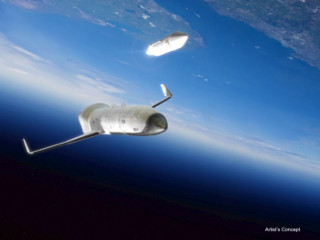 |
| July 22, 2014 | Volume 10 Issue 28 |
Designfax weekly eMagazine
Archives
Partners
Manufacturing Center
Product Spotlight
Modern Applications News
Metalworking Ideas For
Today's Job Shops
Tooling and Production
Strategies for large
metalworking plants
DARPA gets to work on Experimental Spaceplane (XS-1) designs
Three companies get the nod to outline their visions of DARPA's next-generation spaceplane

DARPA's XS-1 program aims to develop a fully reusable unmanned vehicle that would provide aircraft-like access to space.
In an era of declining budgets and adversaries' evolving capabilities, quick, affordable, and routine access to space is increasingly critical for both national and economic security. Current satellite launch systems, however, require scheduling years in advance for a handful of available slots. Launches often cost hundreds of millions of dollars each, due in large part to the massive amounts of dedicated infrastructure and personnel required.
DARPA created its Experimental Spaceplane (XS-1) program to help overcome these challenges and create a new paradigm for more routine, responsive, and affordable space operations. In an important step toward that goal, DARPA has awarded prime contracts for Phase 1 of XS-1 to three companies:
- The Boeing Company (working with Blue Origin, LLC);
- Masten Space Systems (working with XCOR Aerospace); and
- Northrop Grumman Corporation (working with Virgin Galactic).
"We chose performers who could prudently integrate existing and up-and-coming technologies and operations, while making XS-1 as reliable, easy to use, and cost effective as possible," says Jess Sponable, DARPA program manager. "We're eager to see how their initial designs envision making spaceflight commonplace -- with all the potential military, civilian, and commercial benefits that capability would provide."
The XS-1 program aims to develop a fully reusable unmanned vehicle that would provide aircraft-like access to space and deploy small satellites to orbit using expendable upper stages. XS-1 seeks to deploy small satellites faster and more affordably, and develop technology for next-generation hypersonic vehicles.
XS-1 development plans envision a reusable first stage that would fly to hypersonic speeds at a suborbital altitude. At that point, one or more expendable upper stages would separate and deploy a satellite into Low Earth Orbit (LEO). The reusable first stage would then return to earth, land, and be prepared for the next flight. Modular components; durable thermal protection systems; and automatic launch, flight, and recovery systems should significantly reduce logistical needs, enabling rapid turnaround between flights.
Key XS-1 technical goals include flying 10 times in 10 days, flying to Mach 10+ at least once, and launching a representative small payload to orbit. The program also seeks to reduce the cost of access to space for 3,000-lb to 5,000-lb payloads to less than $5 million per flight.
In Phase 1 of XS-1, DARPA intends to evaluate the technical feasibility and methods for achieving the program's goals. Tasks currently include:
- Develop the XS-1 demonstration vehicle.
- Identify and conduct critical risk reduction of core component technologies and processes.
- Develop a technology maturation plan for fabrication and flight test of XS-1 system capabilities.
DARPA expects the performers to explore alternative technical approaches from the perspectives of feasibility, performance, system design, and development and operational costs. They must also assess potential suitability for near-term transition opportunities to military, civil, and commercial users. These opportunities include both launching small payloads per the program goals as well as others, such as supporting future hypersonic testing and a future space access aircraft.
Source: DARPA (The Defense Advanced Research Projects Agency)
Published July 2014
Rate this article
View our terms of use and privacy policy
